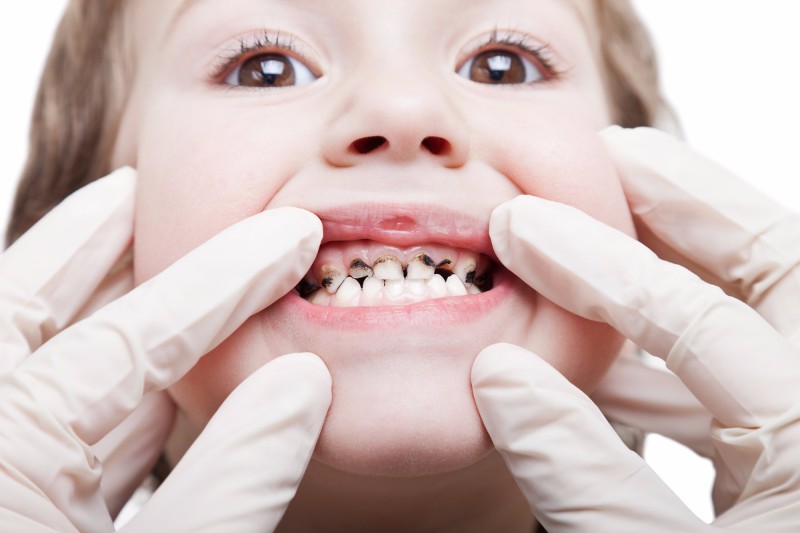Dental caries (tooth decay) is the most common form of the oral disease, affecting more than 50% of the kids and almost all adults.
Contact us, or send us an email of your panoramic x-ray.
We have the experience to help you!
Free ConsultationBy dental definition, dental caries is representing the destruction of the tooth enamel – the outer layer that is protecting the whole tooth.
The early manifestation of the caries is a small spot of demineralization (softer) enamel at the surface of the tooth, which most of the time is hidden into the fissures or in between the teeth. When is not noticed on time, and with time, this white spot will spread into the softer and more sensitive part of the tooth – the dentin. When the demineralization will reach the dentin, the enamel will just collapse into the dentin and form a cavity.
Dental caries is caused by the action of acids on the top layer of the tooth – enamel. This acid is produced when the sugars from the food or drinks will react with the bacteria, which is present in the dental plaque (film on the top of the surface of the tooth). The presence of this acid leads to loss of calcium and phosphate from the enamel – process which is called demineralization.
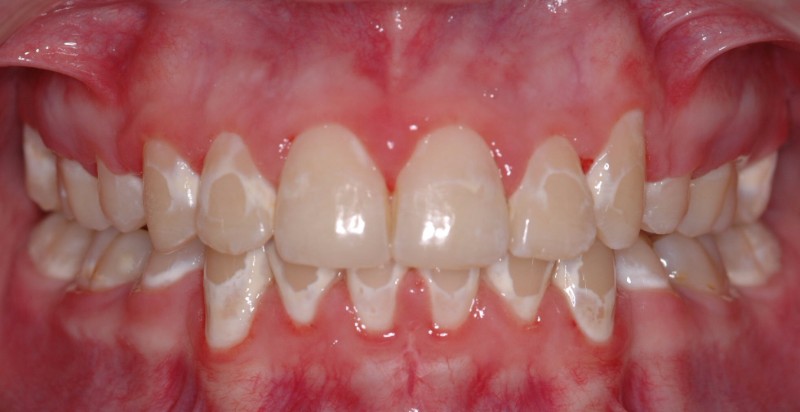 Source: www.oakwoodorthodontics.co.uk
Source: www.oakwoodorthodontics.co.uk
Saliva is the main source that neutralizes the acid. During the day this process happens many times and prevents caries.
Besides the neutralization, the saliva contains minerals that are remineralised and “heal” the dematerialized area of the tooth, by making neutralization and not allowing the creation of a white spot.
The process demineralization/remineralization is reversible up to certain level; when the balance is impaired the caries process is starting.
With many months of demineralization, the enamel surface will crack down, and this will lead to the formation of a cavity.
Where is caries formed?
According to the location where caries can be formed, it can be categorized into 2 major groups.
Pit and fissure caries is the most often formed caries. This type of caries can be found on the chewing surfaces of the molars and premolars, as well at the back of the front teeth. The teeth are composed of few sections of enamel, and these parts meet ant pits and fissures trapping plaque which can lead to forming of caries.
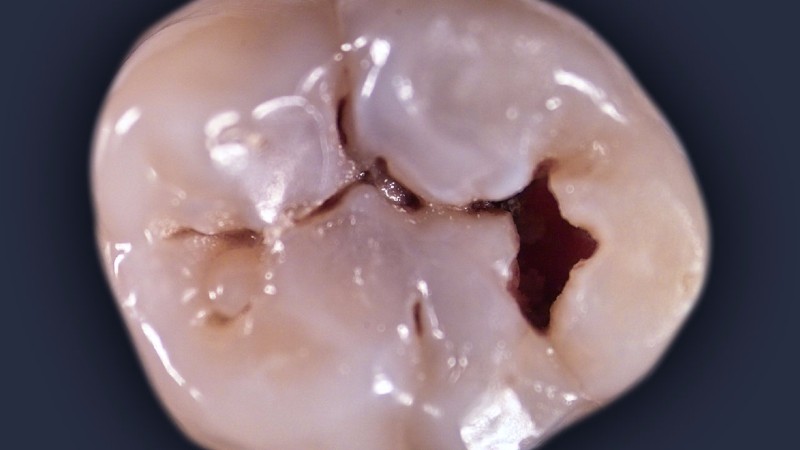 Source: www.m.colgateprofessional.co.th
Source: www.m.colgateprofessional.co.th
Smooth surface caries can be found along the gingiva or between teeth (interproximal space). This type of caries is more present at people who have tight jaw or tooth overlap, which increases the possibility the food sticking between the teeth and disallowed the cleaning.
Besides these two main categories, of caries can be also formed around dental filling or bridge works.
Dental caries beside the affection of the permanent teeth as well can affect the “milk” teeth, and in this case, its progression is much faster because the dentin tubules are wider and the caries progression and formation of the cavity can happen in 1 day.
How should I know that I have dental caries?
When the caries is in the phase of the white spot may not have any symptoms. The earliest that you can notice is the chalky white spot on the surface of the tooth. This already is an indication that the enamel is demineralized. This white spot will continue to demineralize and the color will start to change as well and it will turn from white to brown and the cavity will be formed.
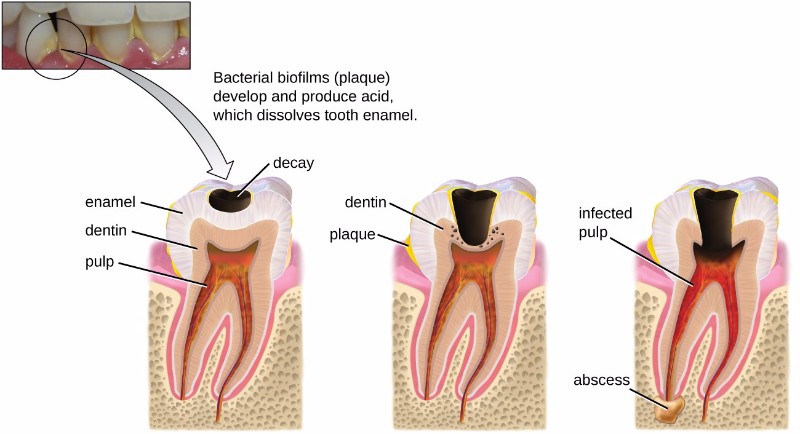 Source: www.courses.lumenlearning.com
Source: www.courses.lumenlearning.com
Once the cavity is formed, it can’t be regenerated. If the color of the tooth is brownish and shiny, that means that the caries is not active anymore – the demineralization stopped. If the decay is active then it has lighter color without any shine. When the dental cavity is created, then it can be manifested in the form of sensitivity to sweet, hot or cold drinks or food.
How the dentist makes the diagnosis of dental caries?
At every visit, the dentist is checking all teeth. All of them will be checked profoundly, and some of them can be a probe with a tool called an explorer that is searching for any damaged area. Usually, this instrument can’t notice when the formation is the chalky white spot, but with the usage of x-ray, the smallest lesion after dentist suspecting can be noticed. The x-ray is very helpful for detection of caries which is located between the teeth.
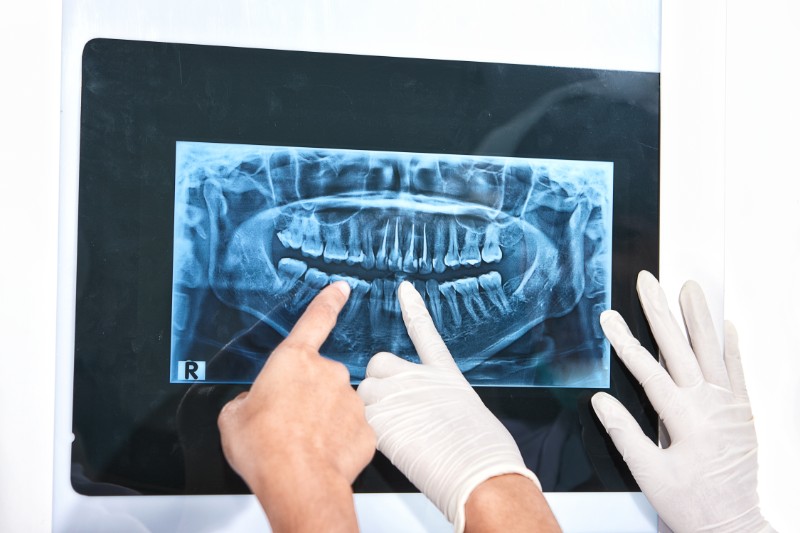 Source: www.palospediatricdentistry.com
Source: www.palospediatricdentistry.com
Some dental offices are using the latest high-tech devices, such as lasers for cavity detection. The laser can detect the earliest formation of caries when that one can be reversed.
How is dental caries treated?
Caries is a process and if detected in the early stages, it can be stopped or even reversed. After caries reaches the dentin and breaks the enamel, it can be only repaired by a dentist.The standard treatment for a cavity is filling the tooth. Dental fillings are restoring cavities and bringing the damaged tooth back to his normal shape and function. There are several types of dental fillings. Which one will be chosen depends on the location of the tooth, the surface of the damaged tooth, as well the budget.
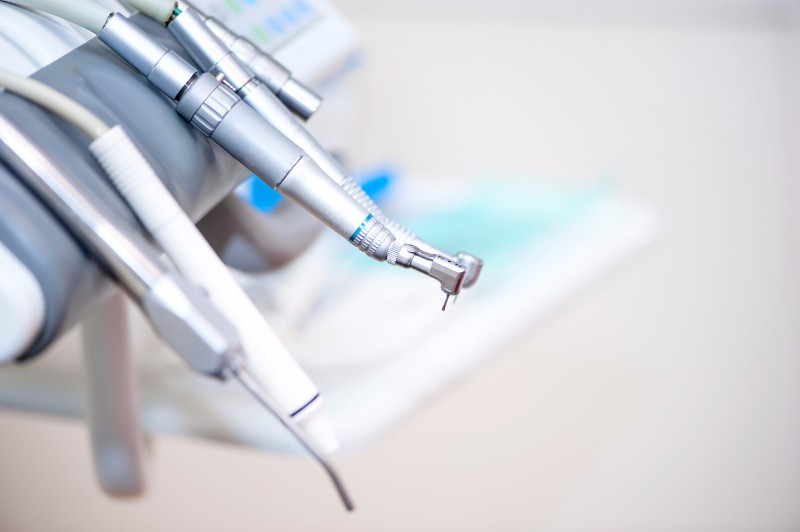 Source: www.parkavenuedentalgnv.com
Source: www.parkavenuedentalgnv.com
Composite fillings are made up from resin and glasslike particles, producing most natural appearance for the restoration. These types of fillings are long lasting with resilient to fractures and can be used at a small to mid-size restorations.
Glass ionomer fillings are easily bonding with the tooth and they are tooth-colored. This type of fillings is releasing fluoride over time, preventing decay under and around the filling. This type of filling is suggested to be used at a younger population – especially at kids, as the filling doesn’t last long.
The amalgam filling was the most used or better to say the only used material, up to recently. This filling is a combination of silver, copper, tin and mercury for creating a strong and stable filling material. It is durable and easy to use, but the aesthetic look of the tooth is non-existent.
If the decay is more than 2/3 of the tooth surface, than a “must” inlay or onlay has to be placed on the tooth, because the tooth surface is not enough to support the filling. This type of fillings are made in the laboratory and afterward, they are cemented into place. They can last up to 20 years. Other solution, if the caries damage is bigger than inlay or onlay filling, then the dental crown is required.
Tooth filling procedure is the following one:
1. Your dentist can give you local anesthesia, so you will not feel a thing.
2. Then the dentist, with a drill with diamante border and will remove and reshape the enamel to support the tooth filling.
3. After the enamel is prepared, the dentist will clean the debris and caries from the dentin, using drill and steel borer, which gently is cleaning caries.
4. After the cavity is clean, without any soft tooth spots or discolored dentin, next step is etching the tooth with acid gel for 30 seconds.
5. Then the acid gel is washed and the cavity is dried. Depends on the filling, the procedure can continue differently. If the composite fillings are the one that is used, a special glue is placed on the tooth surface and with the usage of LED light, it hardens.
6. In meantime, the matching color for the filling is chosen, and a portion is filling up the cavity. After all, the portion is applied with the use of the LED light, this material becomes harder, reaching more or less the same hardness as the tooth.
7. Once the filling is placed, the dentist will polish the tooth, making sure that all surfaces are smooth. The dental filling can last up to 5 years or more, with the proper way of with the proper way of oral hygiene. All procedures usually take up to 30 minutes.
It is usual some patients after tooth restoration to be sensitive on cold or hot drinks, approximately for a week or two. If the pain cannot be handled, the dentist can prescribe some painkillers and antibiotics, so the infection can be avoided.
What will happen if the dental caries is not treated?
If you ignore the pain and the bad breath you are getting from the already formed dental cavity then uncontrolled cavity can destroy the tooth. Without a quick reaction and a sanction on time, the dental pulp (tooth nerves) will be destroyed. Once caries starts affecting the pulp then root treatment should be done, with pulp extraction and canal treatment.
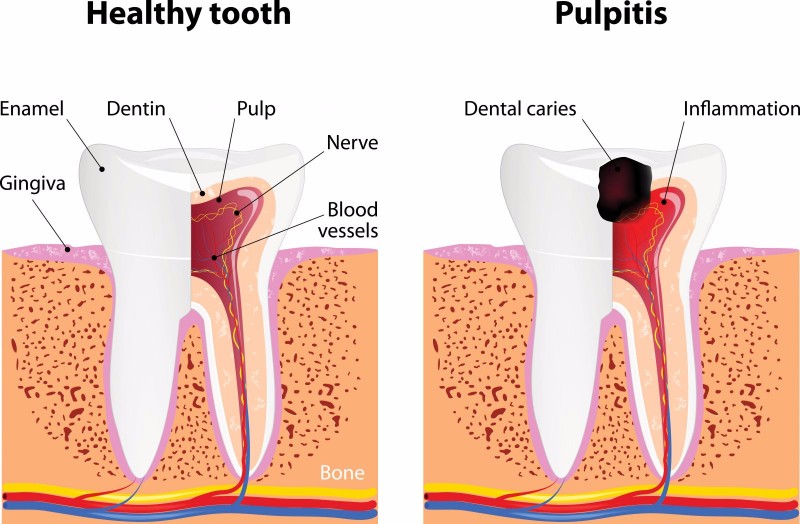 Source: www.promenade-dentist.com
Source: www.promenade-dentist.com
How to prevent dental caries?
Caries is caused by bacteria which means, the more decays you have, the more bacteria exists in the mouth. If you continue with your oral routine which leads to caries, it will appear continually. Try to change the routine of oral care. Furthermore, if it necessary include some dental additions like dental floss or an interdental brush. A professional cleaning twice a year is obligatory as well as daily brushing at least two times per day.
Try to avoid sticky food such as candy or dried fruits as snacks because they get stuck between the teeth allowing bacteria to be multiplied and produce acid. And once you allow the bacteria to enter, that leads to tooth demineralization and caries.
It is obligatory to brush your teeth properly after every meal and rinse them with water. On the other hand, avoid drinks or mints with huge quantities of sugar.
Conclusion:
Dental caries is an oral disease that affects each and every one of us. With demineralization of the tooth surface and getting off the process up to the dentin, the enamel cracks and the dental cavity appears. The early symptoms of caries can are discovered at the dentist with examination and x-ray. The dentist will detect them and prevent from further demineralization. Schedule your FREE checkup at our dental office, in order to prevent tooth damage or cure it.


